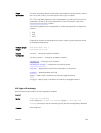
Version Description
9.0.2.0 Introduced on the S6000.
8.3.19.0 Introduced on the S4820T.
8.3.11.0 Introduced on the Z9000.
8.3.7.0 Introduced on the S4810.
8.1.1.0 Introduced on the E-Series ExaScale.
7.6.1.0 Introduced on the S-Series.
7.5.1.0 Introduced on the C-Series.
pre-6.2.1.0 Introduced on the E-Series.
Usage
Information
This command is supported on C-Series, S-Series, and E-Series (TeraScale and
ExaScale) 10/100/1000 Base-T Ethernet interfaces.
The no negotiation auto command is only available if you first manually set
the speed of a port to 10Mbits or 100Mbits.
The negotiation auto command provides a mode option for configuring an
individual port to forced-master/forced slave after you enable auto-negotiation.
NOTE: The mode option is not available on non-10/100/1000 Base-T Ethernet
line cards.
If you do not use the mode option, the default setting is slave. If you do not
configure forced-master or forced-slave on a port, the port negotiates to either a
master or a slave state. Port status is one of the following:
• Forced-master
• Force-slave
• Master
• Slave
• Auto-neg Error — typically indicates that both ends of the node are configured
with forced-master or forced-slave.
CAUTION: Ensure that one end of your node is configured as forced-master
and one is configured as forced-slave. If both are configured the same (that
is, forced-master or forced-slave), the show interfaces command flaps
between an auto-neg-error and forced-master/slave states.
You can display master/slave settings with the show interfaces command.
Example
(Master/Slave)
Dell(conf)# interface tengigabitethernet 1/1
Dell(conf-if)#neg auto
Dell(conf-if-autoneg)# ?
end Exit from configuration mode
exit Exit from autoneg configuration mode
mode Specify autoneg mode
no Negate a command or set its defaults
show Show autoneg configuration information
Interfaces
813


















